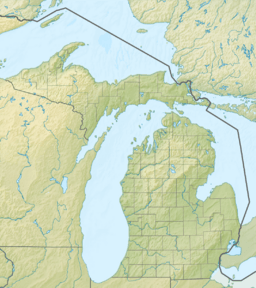Budd Lake (Michigan) facts for kids
Quick facts for kids Budd Lake |
|
|---|---|
| Location | Clare County, Michigan |
| Coordinates | 44°01′22″N 84°47′48″W / 44.02278°N 84.79667°W |
| Basin countries | United States |
| Max. length | 2,300 m (1.4 mi) |
| Max. width | 400 m (0.25 mi) |
| Surface area | 175 acres (0.7 km2) |
| Max. depth | 35 feet (11 m) |
| Surface elevation | 1,112 feet (339 m) |
| Settlements | Harrison |
Budd Lake is a beautiful lake in Clare County, located in the middle part of Michigan's lower peninsula. It covers about 175 acres (0.7 square kilometers) and is a popular place for outdoor activities.
Wilson State Park is a lovely park right next to Budd Lake. It has lots of trees and places for camping, with 160 campsites. The park also has a sandy beach where you can relax and enjoy the water. A long time ago, in the early 1900s, there were lumber mills around the lake. The land for Wilson State Park was actually given to Michigan by a lumber company that operated in the late 1800s.
Budd Lake is very popular for fishing! Many anglers (that's what we call people who fish) come here. You can find big fish like muskies, some even longer than 40 inches! Other fish you might catch include bass, panfish, perch, and walleye. The lake can be up to 30 feet deep in some spots, especially near the shore, which provides good hiding places for fish. The south end of the lake is usually shallower.
There is a public boat ramp at the southern end of the lake, making it easy for people to launch their boats.
Understanding VHS Fish Disease
In 2007, the Michigan DNR announced that Budd Lake was the first inland lake in Michigan to be confirmed with a fish disease called viral hemorrhagic septicemia (VHS). This disease is caused by a virus that can make fish sick.
What is VHS?
VHS is an infectious virus that can spread among fish. It can cause many different kinds of fish to become ill. It's important to know that this disease does not affect humans.
How VHS Spreads
The VHS virus can spread from one body of water to another in several ways. This includes through live or frozen bait fish, fish eggs (roe), fishing equipment that hasn't been cleaned, live water wells in boats, and even water carried in boats. To help stop the spread, it's a good idea to clean and disinfect your boats and fishing gear before moving them from Budd Lake to other lakes or rivers.
Recent Findings
The Michigan DNR confirmed that the virus was still present in Budd Lake in 2011. This was after some bass, bluegills, and pumpkinseed sunfish became sick. Scientists used special tests to confirm the virus was still there.


